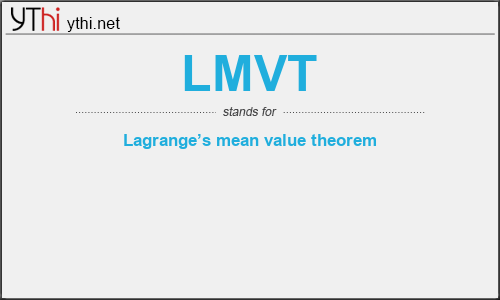What does LMVT mean? What is the full form of LMVT?
The Full Form of LMVT is Lagrange’s mean value theorem.
Lagrange’s mean value theorem (MVT) states that if a function f(x) is continuous on a closed interval [a,b] and differentiable on the open interval (a,b), then there is at least one point x=c on this interval, such that
f(b)−f(a)=f′(c)(b−a).
This theorem (also known as First Mean Value Theorem) allows to express the increment of a function on an interval through the value of the derivative at an intermediate point of the segment.
Proof.
Consider the auxiliary function
F(x)=f(x)+λx.
We choose a number λ such that the condition F(a)=F(b) is satisfied. Then
f(a)+λa=f(b)+λb,⇒f(b)−f(a)=λ(a−b),⇒λ=−f(b)−f(a)b−a.
As a result, we have
F(x)=f(x)−f(b)−f(a)b−ax.
The function F(x) is continuous on the closed interval [a,b], differentiable on the open interval (a,b) and takes equal values at the endpoints of the interval. Therefore, it satisfies all the conditions of Rolle’s theorem. Then there is a point c in the interval (a,b) such that
F′(c)=0.
It follows that
f′(c)−f(b)−f(a)b−a=0
or
f(b)−f(a)=f′(c)(b−a).
LMVT
means
Lagrange’s mean value theorem![]()
Translate Lagrange’s mean value theorem to other language.


Leave a Reply
You must be logged in to post a comment.